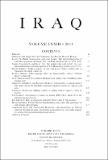The Spatial Dimensions of Early Mesopotamian Urbanism: The Tell Brak Suburban Survey, 2003-2006

View/
Published Version
http://www.britac.ac.uk/INSTITUTES/IRAQ/journal.htmMetadata
Show full item recordCitation
Ur, Jason, Philip Karsgaard, and Joan Oates. 2011. The Spatial Dimensions of Early Mesopotamian Urbanism: The Tell Brak Suburban Survey, 2003-2006. Iraq 73: 1-19.Abstract
The 2003–2006 Suburban Survey at Tell Brak investigated the spatial dimensions of the city’s urban origins and evolution via intensive systematic surface survey. This report places this research in the broader context of research on Near Eastern urban origins and development, describes the survey and remote sensing methods and summarises the results, which challenge several long-held models for the timing and geographical origins of urbanism in the Near East. Urbanism at Brak coalesced over the course of several centuries in the late fifth and early fourth millennia BC, when it evolved from a series of spatially discrete settlement zones into a 130-hectare city, without the benefit of irrigated agriculture. Other urban phases occurred in the late third millennium (70 hectare) and in the Late Bronze Age (45 hectare), all with different urban morphologies. Brak’s final settlement occurred in the Abbasid period, when a 14-hectare town grew around the Castellum. In addition to the timing, growth and variability of urban form at the site, the Suburban Survey also documented well preserved off-site ancient landscapes of tracks, field systems and irrigation canals.Terms of Use
This article is made available under the terms and conditions applicable to Other Posted Material, as set forth at http://nrs.harvard.edu/urn-3:HUL.InstRepos:dash.current.terms-of-use#LAACitable link to this page
http://nrs.harvard.edu/urn-3:HUL.InstRepos:5366597
Collections
- FAS Scholarly Articles [18292]
Contact administrator regarding this item (to report mistakes or request changes)


